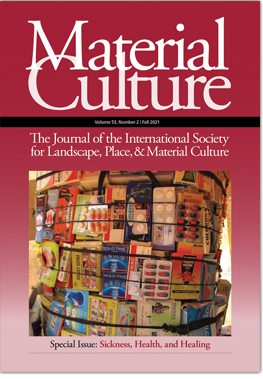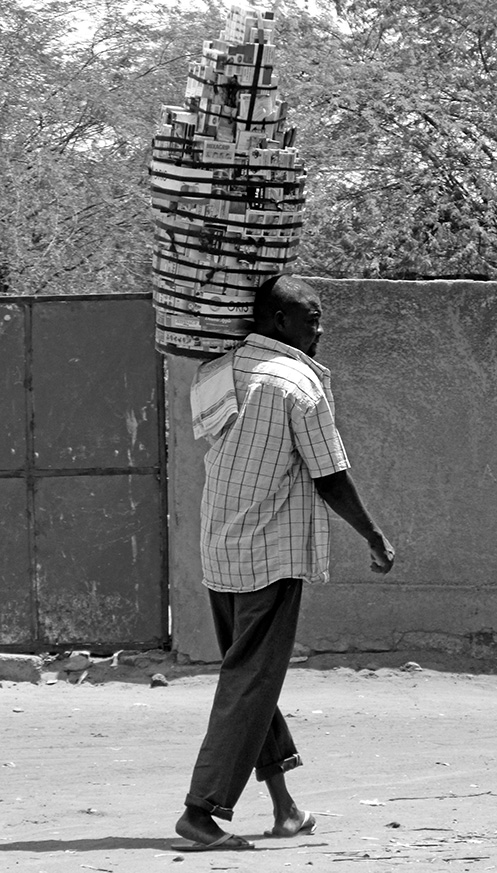Material Culture Culture is printed two times a year for members of PAS:APAL. It is abstracted and indexed in: JSTOR, ProQuest, History and Life, Historical Abstracts, GeoAbstracts, and the MLA International Bibliography. You may download a PDF of the table of contents of the current issue here. The Fall 2021 issue of Material Culture includes:
 Akwaku: The Itinerant Pharmaceutical Vendors of Niamey, Niger
Akwaku: The Itinerant Pharmaceutical Vendors of Niamey, Niger
Scott M. Youngstedt, Department of Sociology, Saginaw Valley State University
Abstract: This article focuses on the sociocultural and economic dimensions of the informal distribution of pharmaceuticals by akwaku (“itinerant drug vendors”) in Niamey, Niger. It unravels the dynamics behind the rising attractiveness of pharmaceuticals in Niamey despite the lingering uncertainty about and poor reputation of biomedicine among Nigériens by analyzing how akwaku generate trust in pharmaceuticals through the ways that they present themselves and their products and interact with clients. This article draws on ethnographic research involving structured interviews with 60 akwaku and 67 clients in ten neighborhoods of Niamey conducted over three months in 2017 and 2018.

An akwaku carrying a medicine tower. Photo byScott M. Youngstedt.
Library Books in Quarantine: The Fears of Shared Books During Times of Contagion
Sherrin Frances, Department of English, Saginaw Valley State University
Abstract: This article considers the American public library practice of quarantining books during times of contagion, specifically during the Great Book Scare in the late 19th century and most recently during the Covid-19 pandemic in 2020/21. The article argues that scientific evidence does not support the excessively long period of Covid-19 quarantine implemented for library books from 2020 to 2021. Instead, this cautious approach is simply a performance in response to the public’s fears, which are threefold. The first is the obvious fear of the unknown as a new disease spreads. The second is the less recognized fear of intimate reading practices and unhygienic behaviors. And finally, the third fear is a philosophical fear of an intrusion by a stranger thus forcing us to contend with our own body’s inability to keep us safe from death. Book quarantines benefit the public by functioning as a metaphor for our need to contain and protect control over our own death.****
Healing WW1 Soldiers with Craft Therapy and its Photographic Narratives of Masculine Ableism and White Privilege
Jennifer Way, Department of Art History, University of North Texas
Abstract: During WW1, a new therapeutic modality featuring craft was being used to heal injured soldiers so that ultimately, they could undertake the social and economic responsibilities that helped define their identity as American men. This nascent strand of occupational therapy aimed to divert the convalescing soldiers’ attention from their pain and focus their minds on making craft objects so their bodies would follow and move in ways that proved rehabilitative. As they healed and could leave their beds and move about in hospital wards and therapy workshops, it was hoped that in making craft objects, these men also learned skills they could apply in jobs in the civilian economy. This is not to say all soldiers could access the same type and quality of care, or that making craft ameliorated social suffering based on race. To these points, this essay analyzes an unstudied photograph created by the American photographer Lewis Hine, along with photographs of the same period having similar content, for the ways they depicted ableist masculinity intersecting White privilege in contexts of craft-based healing and in conversation with civilian craft production. By contextualizing features of Hine’s photograph and similar examples in discourses of race comprising segregation, racism, and White privilege, craft therapy and its photography emerge as a means through which rehabilitating the minds and bodies of war-involved men reiterated race-based inequalities in post-WW1 America.
The Fabric of Care in French Colonial Disaster Relief: Algerian Refugee Tents and the Soft Material Culture of the Colonial Habitus
Maia Nichols, Department of Visual Arts, University of California, San Diego
Abstract: This essay contributes an art historical approach to material culture studies through an analysis of the social and political effects of French colonial disaster relief in 1954. The tent, as a provision, is analyzed as a “soft” and unstable home, whose cloth physicality is interpretable through the social fabric, context, and relations amongst individuals, family life, and colonialism at the start of the Algerian war. Bourdieu’s habitus theoretically grounds an argument for tents as involved in the negotiation of power and liberation struggle in daily life in French Algeria.
